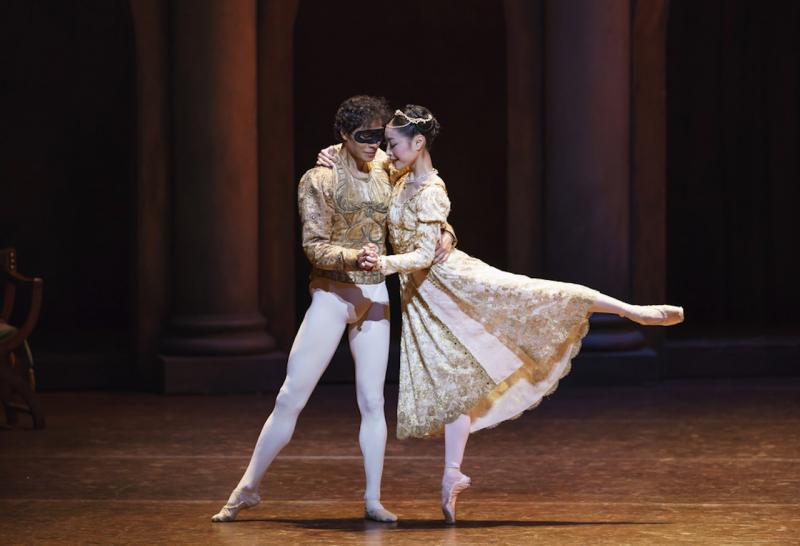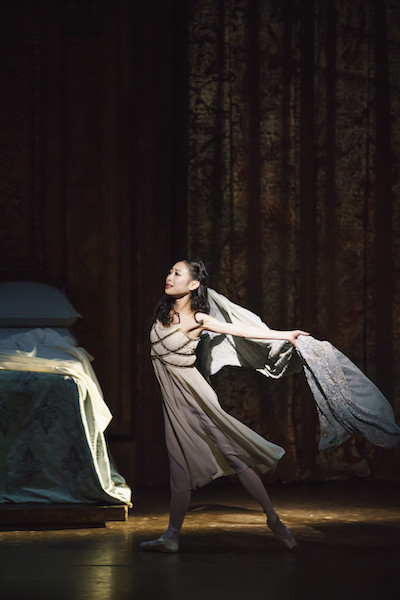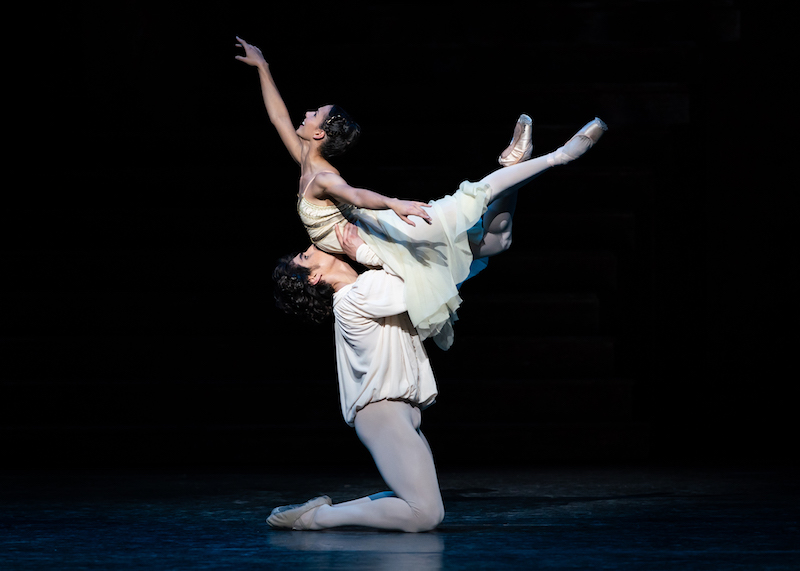Romeo and Juliet, Birmingham Royal Ballet & Royal Ballet review - a storming start to the season | reviews, news & interviews
Romeo and Juliet, Birmingham Royal Ballet & Royal Ballet review - a storming start to the season
Romeo and Juliet, Birmingham Royal Ballet & Royal Ballet review - a storming start to the season
Half a century on MacMillan's R&J is still the business

Two households, both alike in dignity … and both launching their respective seasons with a production of Kenneth MacMillan’s Romeo and Juliet.
A box office hit since its premiere in 1965, the production is a cornerstone of the Royal Ballet’s repertory, regularly re-visited at Covent Garden and danced by an ever-growing number of companies from Stockholm to New York. But Birmingham has its own unique version, personally tailored for BRB in 1992 by MacMillan. With new sets and costumes, it premiered at the Birmingham Hippodrome only months before the choreographer’s death. Watching this at a matinee there the other day felt, as a colleague put it, like meeting the non-identical twin of an old friend. The two versions share much of their DNA but there are differences, some subtle, others more defining.
 Birmingham’s designs by the late Paul Andrews, built for touring, are much less grand than the palatial spaces of Nicholas Georgiadis’s vision for the original, whose effect of dwarfing the supposed-teenage protagonists was deliberate. Both designs are strong on pillars and flights of steps (Juliet has to descend from that balcony somehow), but in the later version Juliet’s bed (pictured right) is less like a mortuary slab and her prié-dieu more prominent, overlaying her reactions with a religious impulse. In BRB's Mandolin dance the acrobats, dressed head-to-toe in shag-pile onesies, resemble Labradoodles off the leash after a too-long spell in kennels, which delivers a welcome shot of frivolity before the stormclouds gather. In a much grislier final scene, the Capulet mausoleum already contains two loosley wrapped corpses – the one with the feet poking out you assume to be that of cousin Tybalt.
Birmingham’s designs by the late Paul Andrews, built for touring, are much less grand than the palatial spaces of Nicholas Georgiadis’s vision for the original, whose effect of dwarfing the supposed-teenage protagonists was deliberate. Both designs are strong on pillars and flights of steps (Juliet has to descend from that balcony somehow), but in the later version Juliet’s bed (pictured right) is less like a mortuary slab and her prié-dieu more prominent, overlaying her reactions with a religious impulse. In BRB's Mandolin dance the acrobats, dressed head-to-toe in shag-pile onesies, resemble Labradoodles off the leash after a too-long spell in kennels, which delivers a welcome shot of frivolity before the stormclouds gather. In a much grislier final scene, the Capulet mausoleum already contains two loosley wrapped corpses – the one with the feet poking out you assume to be that of cousin Tybalt.
This is a production stuffed with relishable details and that includes the principals’ acting. These are characters and choreography that Birmingham’s director, Carlos Acosta, knows inside out (his own performances at the Royal Ballet with Tamara Rojo set the bar high) and it's clear that he has had a hand in coaching here. Chilean-born Romeo César Morales (pictured top) is more lightly built than Acosta but has a similar softly padded grace, inhabiting the stage with a simplicity that is very affecting.
As Juliet, tiny Momoko Hirata (pictured top and above right) is so perfect as the rosebud girl-child of the early scenes that it’s hard to believe she will be able to summon the strength – either physical or mental – to become the driver of the story. But those sparrow limbs are steely, and Hirata’s acting inexorably draws us in to share her terrible dilemma. I have never felt more dread in those moments before she takes the potion – suspicion, despair, abject terror, this Juliet runs the gamut and takes you with her into the dark.
Other outstanding performances in the cast I saw included Tzu-Chao Chou’s hyperactive Mercutio, with Haoliang Feng’s Benvolio a goofily doting sidekick. Meanwhile Rory Mackay stripped Tybalt of any shred of nobility by making him an out-and-out murderous thug, permanently tanked. There was no ambiguity around the thrust that did for poor Mercutio – it was lethally intended, with no remorse.
The Royal Ballet Sinfonia, conducted by Philip Ellis, steered Prokofiev’s score (some would say the greatest ever written for ballet) with a steady hand, his slower tempi adding 10 minutes or more to the Royal Ballet’s timing. How interesting that choreographers – often intransigent on other things – rarely stipulate the running time. The recent film of Romeo and Juliet featuring dancers from the Royal Ballet and shot on location by the BalletBoyz (available on DVD and highly recommended) edits the score by a third, and you'd be hard pressed to say what's missing.
The Royal Ballet may have missed a trick in not duplicating the cast of that cinematic enterprise, a popular watch on BBC TV's culture strand over lockdown. Instead the opening night featured the same Juliet, Nurse and Tybalt, but switched the excellent Romeo, William Bracewell, to a later cast with a different girl. Instead, Francesca Hayward was paired with newly promoted Mexican-born principal Cesar Corrales (not to be confused with BRB's César Morales, I do hope you're keeping up), perhaps because they have an off-stage relationship. This is a risky gameplan, for obvious reasons, but on this occasion it paid dividends in terms of their easy intimacy. These star-crossed lovers actually shared a laugh – genuinely spontaneous it seemed – in a particularly joyous balcony scene. Technically, though, Corrales seemed to struggle with lifting his Juliet (both pictured below), despite Hayward's being among the Royal's smaller girls. This didn't however prevent her giving an astounding performance – a headstrong, impulsive Juliet from the start – very much in the mould of the great Tamara Rojo.

Koen Kessels, directing the Royal Opera House Orchestra, wrings every drop of gorgeousness from the score. Too bad on opening night the four mandolin players – stationed in a box – came rhythmically adrift from the main body of the orchestra for an unnerving stretch of time, additionally knocking the solo clarinet into freefall. But it's hardly the conductor's fault if players fail to watch his beat, and the run is plenty long enough to sort this out.
The future of Arts Journalism
You can stop theartsdesk.com closing!
We urgently need financing to survive. Our fundraising drive has thus far raised £49,000 but we need to reach £100,000 or we will be forced to close. Please contribute here: https://gofund.me/c3f6033d
And if you can forward this information to anyone who might assist, we’d be grateful.

Subscribe to theartsdesk.com
Thank you for continuing to read our work on theartsdesk.com. For unlimited access to every article in its entirety, including our archive of more than 15,000 pieces, we're asking for £5 per month or £40 per year. We feel it's a very good deal, and hope you do too.
To take a subscription now simply click here.
And if you're looking for that extra gift for a friend or family member, why not treat them to a theartsdesk.com gift subscription?
more Dance
 'We are bowled over!' Thank you for your messages of love and support
Much-appreciated words of commendation from readers and the cultural community
'We are bowled over!' Thank you for your messages of love and support
Much-appreciated words of commendation from readers and the cultural community
 How to be a Dancer in 72,000 Easy Lessons, Teaċ Daṁsa review - a riveting account of a life in dance
Michael Keegan-Dolan's unique hybrid of physical theatre and comic monologue
How to be a Dancer in 72,000 Easy Lessons, Teaċ Daṁsa review - a riveting account of a life in dance
Michael Keegan-Dolan's unique hybrid of physical theatre and comic monologue
 A Single Man, Linbury Theatre review - an anatomy of melancholy, with breaks in the clouds
Ed Watson and Jonathan Goddard are extraordinary in Jonathan Watkins' dance theatre adaptation of Isherwood's novel
A Single Man, Linbury Theatre review - an anatomy of melancholy, with breaks in the clouds
Ed Watson and Jonathan Goddard are extraordinary in Jonathan Watkins' dance theatre adaptation of Isherwood's novel
 Peaky Blinders: The Redemption of Thomas Shelby, Rambert, Sadler's Wells review - exciting dancing, if you can see it
Six TV series reduced to 100 minutes' dance time doesn't quite compute
Peaky Blinders: The Redemption of Thomas Shelby, Rambert, Sadler's Wells review - exciting dancing, if you can see it
Six TV series reduced to 100 minutes' dance time doesn't quite compute
 Giselle, National Ballet of Japan review - return of a classic, refreshed and impeccably danced
First visit by Miyako Yoshida's company leaves you wanting more
Giselle, National Ballet of Japan review - return of a classic, refreshed and impeccably danced
First visit by Miyako Yoshida's company leaves you wanting more
 Quadrophenia, Sadler's Wells review - missed opportunity to give new stage life to a Who classic
The brilliant cast need a tighter score and a stronger narrative
Quadrophenia, Sadler's Wells review - missed opportunity to give new stage life to a Who classic
The brilliant cast need a tighter score and a stronger narrative
 The Midnight Bell, Sadler's Wells review - a first reprise for one of Matthew Bourne's most compelling shows to date
The after-hours lives of the sad and lonely are drawn with compassion, originality and skill
The Midnight Bell, Sadler's Wells review - a first reprise for one of Matthew Bourne's most compelling shows to date
The after-hours lives of the sad and lonely are drawn with compassion, originality and skill
 Ballet to Broadway: Wheeldon Works, Royal Ballet review - the impressive range and reach of Christopher Wheeldon's craft
The title says it: as dancemaker, as creative magnet, the man clearly works his socks off
Ballet to Broadway: Wheeldon Works, Royal Ballet review - the impressive range and reach of Christopher Wheeldon's craft
The title says it: as dancemaker, as creative magnet, the man clearly works his socks off
 The Forsythe Programme, English National Ballet review - brains, beauty and bravura
Once again the veteran choreographer and maverick William Forsythe raises ENB's game
The Forsythe Programme, English National Ballet review - brains, beauty and bravura
Once again the veteran choreographer and maverick William Forsythe raises ENB's game
 Sad Book, Hackney Empire review - What we feel, what we show, and the many ways we deal with sadness
A book about navigating grief feeds into unusual and compelling dance theatre
Sad Book, Hackney Empire review - What we feel, what we show, and the many ways we deal with sadness
A book about navigating grief feeds into unusual and compelling dance theatre
 Balanchine: Three Signature Works, Royal Ballet review - exuberant, joyful, exhilarating
A triumphant triple bill
Balanchine: Three Signature Works, Royal Ballet review - exuberant, joyful, exhilarating
A triumphant triple bill
 Romeo and Juliet, Royal Ballet review - Shakespeare without the words, with music to die for
Kenneth MacMillan's first and best-loved masterpiece turns 60
Romeo and Juliet, Royal Ballet review - Shakespeare without the words, with music to die for
Kenneth MacMillan's first and best-loved masterpiece turns 60

Add comment